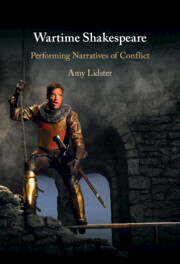Book contents
- Wartime Shakespeare
- Wartime Shakespeare
- Copyright page
- Dedication
- Contents
- Figures
- Acknowledgements
- Note on the Text
- Introduction
- Part I
- Part II
- Chapter 4 Fragmenting Shakespeare(s) and the First World War (1914–18)
- Chapter 5 ‘What We Are Fighting For’
- Chapter 6 ‘Anti-War’ Shakespeare
- Conclusion
- Select Bibliography
- Index
Chapter 4 - Fragmenting Shakespeare(s) and the First World War (1914–18)
from Part II
Published online by Cambridge University Press: 12 October 2023
- Wartime Shakespeare
- Wartime Shakespeare
- Copyright page
- Dedication
- Contents
- Figures
- Acknowledgements
- Note on the Text
- Introduction
- Part I
- Part II
- Chapter 4 Fragmenting Shakespeare(s) and the First World War (1914–18)
- Chapter 5 ‘What We Are Fighting For’
- Chapter 6 ‘Anti-War’ Shakespeare
- Conclusion
- Select Bibliography
- Index
Summary
It tends to be assumed that Shakespeare was enthusiastically mobilized as a patriotic figurehead during the First World War. Evidence of this practice can be found throughout the conflict, most often by individuals who had a prior vested interest in Shakespeare; but Chapter 4 exposes the dramatist’s contested position by examining four kinds of fragmentation that clarify his presence on wartime stages: fragmented users, fragmented texts, fragmented appeal, and fragmented evidence. It builds on Chapter 3’s discussion of patriotism, a concept that seems to indicate confidence and unity, but often reveals division. Chapter 4 evaluates the work of passionate theatre practitioners such as Frank Benson and Lena Ashwell who saw the performance of Shakespeare as a national service that could boost morale, raise funds, and educate both civilians and troops. It shows how the memoirs, public statements, and articles authored by these individuals have had an outsized influence in mediating our understanding of Shakespeare’s appeal. This chapter considers Benson’s performances within Britain; Ashwell’s work with the YMCA on the frontline and the provision of entertainment to troops; and, finally, the use of Shakespeare as part of theatre in Ruhleben, a civilian internment camp in Germany.
Keywords
- Type
- Chapter
- Information
- Wartime ShakespearePerforming Narratives of Conflict, pp. 159 - 197Publisher: Cambridge University PressPrint publication year: 2023

